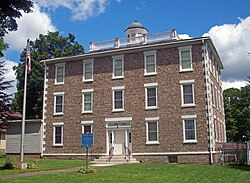Alexander Classical School
|
Alexander Classical School
|
|

South elevation and east profile, 2010
|
|
| Location | Alexander, NY |
|---|---|
| Nearest city | Batavia |
| Coordinates | 42°54′8″N 78°15′34″W / 42.90222°N 78.25944°WCoordinates: 42°54′8″N 78°15′34″W / 42.90222°N 78.25944°W |
| Built | 1837 |
| Architect | Unknown |
| Architectural style | Other |
| NRHP Reference # | 73001191 |
| Added to NRHP | October 25, 1973 |
The former Alexander Classical School, today Alexander Town Hall, is located on Buffalo Street in Alexander, New York, United States. It is a three-story cobblestone building erected in the 1830s.
It has a number of distinctions among cobblestone buildings, many of which are located in the region of New York south of Lake Ontario where the cobblestones used were sourced. It is one of the few to reach three stories high, and one of the few originally designed for educational purposes. It is the only one anywhere in North America currently used as a public building. The upper floor serves as a local history museum.
First home to a private school, it later became a public school building after the private school failed. When that ended, the building became the town hall. It was listed on the National Register of Historic Places in 1973, the southernmost listing in Genesee County and the only cobblestone building listed in the county.
The building is located on the north side of Buffalo Street, roughly a quarter-mile (500 m) east of where it forks south from U.S. Route 20, of which it was once part. Alexander Central School is just across the street; the other buildings in the area are residential. The land slopes down towards Tonawanda Creek to the east.
Tall mature trees along Buffalo Street provide shade. A narrow walk in the middle of the lawn goes the depth of the setback, equivalent to the distance to the rear wall of neighboring houses. In the rear, on Church Street, is a large parking lot for town officials and employees.
The building itself is a three-story five-by-four-bay structure faced in cobblestones 4–7 inches (10–18 cm) wide on the front set amid mortar. There are three rows of cobblestones per limestone quoin on the front and four per quoin on the end walls, where the stones are 2–2.5 inches (5.1–6.4 cm) wide. The windowsills, lintels and water table are also of limestone.
...
Wikipedia


